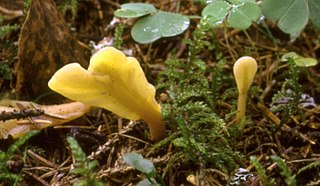
Spathularia flavida, commonly known as the yellow earth tongue, the yellow fan, or the fairy fan, is an ascomycete fungus found in coniferous forests of Asia, Europe and North America. It produces a small, fan- or spoon-shaped fruit body with a flat, wavy or lobed cream to yellow colored "head" raised on a white to cream stalk. The height is usually approximately 2–5 cm, and up to 8 cm. The fungus fruits on the ground in mosses, forest duff or humus, and fruit bodies may occur singly, in large groups, or in fairy rings. The spores produced by the fungus are needle-like, and up to 95 µm long. Several varieties have been described that differ largely in their microscopic characteristics. S. flavida has been described by authorities variously as inedible, of unknown edibility, or edible but tough.
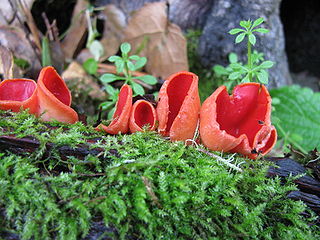
Sarcoscypha coccinea, commonly known as the scarlet elf cup, or the scarlet cup, is a species of fungus in the family Sarcoscyphaceae of the order Pezizales. The fungus, widely distributed in the Northern Hemisphere, has been found in Africa, Asia, Europe, North and South America, and Australia. The type species of the genus Sarcoscypha, S. coccinea has been known by many names since its first appearance in the scientific literature in 1772. Phylogenetic analysis shows the species to be most closely related to other Sarcoscypha species that contain numerous small oil droplets in their spores, such as the North Atlantic island species S. macaronesica. Due to similar physical appearances and sometimes overlapping distributions, S. coccinea has often been confused with S. occidentalis, S. austriaca, and S. dudleyi.

Paragyromitra infula, commonly known as the hooded false morel or the elfin saddle, is a species of fungus in the family Discinaceae. The dark reddish-brown caps of the fruit bodies develop a characteristic saddle-shape in maturity, and the ends of both saddle lobes are drawn out to sharp tips that project above the level of the fruit body. The stipe is white or flushed pale brown, smooth on the outside, but hollow with some chambers inside.

Gyromitra caroliniana, known commonly as the Carolina false morel or big red, is an ascomycete fungus of the genus Gyromitra, within the Pezizales group of fungi. It is found in hardwood forests of the southeastern United States, where it fruits in early spring soon after snowmelt.
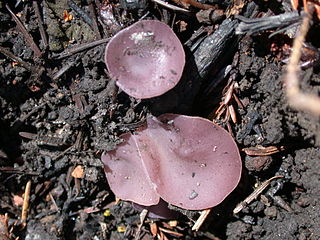
Peziza violacea, commonly known as the violet fairy cup or the violet cup fungus, is a species of fungus in the genus Peziza of the family Pezizaceae. As both it common names and specific epithet suggest, the cup-shaped fruiting bodies are violet colored on the interior surface. P. violacea is typically found growing on burnt soil.
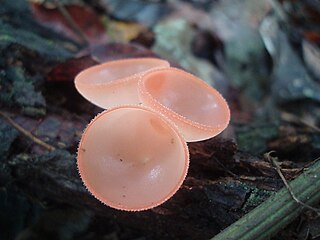
Cookeina is a genus of cup fungi in the family Sarcoscyphaceae, members of which may be found in tropical and subtropical regions of the world. Species may be found on fallen branches of angiosperms, trunks, and sometimes on fruits. The Temuans of Peninsular Malaysia are reported to use certain species from this genus as food, and also as a bait for fishing, where it is rubbed against the hook.

Geopyxis carbonaria is a species of fungus in the genus Geopyxis, family Pyronemataceae. First described to science in 1805, and given its current name in 1889, the species is commonly known as the charcoal loving elf-cup, dwarf acorn cup, stalked bonfire cup, or pixie cup. The small, goblet-shaped fruitbodies of the fungus are reddish-brown with a whitish fringe and measure up to 2 centimetres across. They have a short, tapered stalk.

Scutellinia scutellata, commonly known as the eyelash pixie cup, eyelash cup, the Molly eye-winker, the scarlet elf cap, the eyelash fungus or the eyelash pixie cup, is a small saprophytic fungus in the family Pyronemataceae. It is the type species of Scutellinia, as well as being the most common and widespread. The fruiting bodies are small red cups with distinctive long, dark hairs or "eyelashes". These eyelashes are the most distinctive feature and are easily visible with a magnifying glass.

Chorioactis is a genus of fungi that contains the single species Chorioactis geaster. The mushroom is commonly known as the devil's cigar or the Texas star in the United States, while in Japan it is called kirinomitake (キリノミタケ). This extremely rare mushroom is notable for its unusual appearance and disjunct distribution; it is found only in select locales in Texas and Japan. The fruit body, which grows on the stumps or dead roots of cedar elms or dead oaks, somewhat resembles a dark brown or black cigar before it splits open radially into a starlike arrangement of four to seven leathery rays. The interior surface of the fruit body bears the spore-bearing tissue known as the hymenium, and is colored white to brown, depending on its age. The fruit body opening can be accompanied by a distinct hissing sound and the release of a smoky cloud of spores.

Verpa bohemica is a species of fungus in the family Morchellaceae. The synonym Ptychoverpa bohemica is often used by European mycologists and it is commonly known as the early morel or the wrinkled thimble-cap. The mushroom has a pale yellow or brown thimble-shaped cap—2 to 4 cm in diameter by 2 to 5 cm long—that has a surface wrinkled and ribbed with brain-like convolutions. A feature distinguishing the species from true morels, the cap hangs free from the top of the stem, which is lighter in color, brittle, and up to 12 cm long by 1 to 2.5 cm thick. Microscopically, the mushroom is distinguished by its large spores, typically 60–80 by 15–18 µm, and the presence of only two spores per ascus.
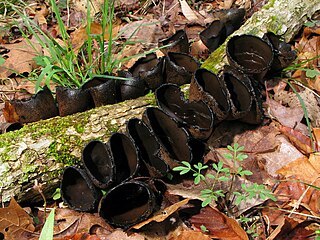
Urnula craterium is a species of cup fungus in the family Sarcosomataceae. Appearing in early spring, its distinctive goblet-shaped and dark-colored fruit bodies have earned it the common names crater cup, devil's urn and the gray urn. The asexual (imperfect), or conidial stage of U. craterium is a plant pathogen known as Conoplea globosa, which causes a canker disease of oak and several other hardwood tree species.

Pseudoplectania is a genus of fungi in the family Sarcosomataceae. The genus contains 12 species. Pseudoplectania ryvardenii was described in 2012, while Pseudoplectania carranzae was transferred to the genus in 2013.

Wynnea is a genus of fungi in the family Sarcoscyphaceae. Circumscribed by Miles Joseph Berkeley and Moses Ashley Curtis in 1867, the genus contains seven species that have ear-shaped fruit bodies that grow on the ground. Wynnea species have a worldwide distribution and have been collected from the United States, Costa Rica, India, and China.

Wynnea americana, commonly known as moose antlers or rabbit ears, is a species of fungus in the family Sarcoscyphaceae. The uncommon species is recognizable by its spoon-shaped or rabbit ear–shaped fruit bodies that may reach up to 13 cm (5 in) tall. It has dark brown and warty outer surfaces, while the fertile spore-bearing inner surface is orange to pinkish to reddish brown. It is distinguished from other species in its genus by the pustules on the outer surface, and microscopically by the large asymmetrical longitudinally ribbed spores with a sharply pointed tip. The spores are made in structures called asci, which have thickened rings at one end that are capped by a hinged structure known as the operculum—a lid that opens to release spores from the ascus.

Pseudoplectania nigrella, commonly known as the ebony cup, the black false plectania, or the hairy black cup, is a species of fungus in the family Sarcosomataceae. The fruit bodies of this saprobic fungus are small blackish cups, typically up to 2 cm broad.
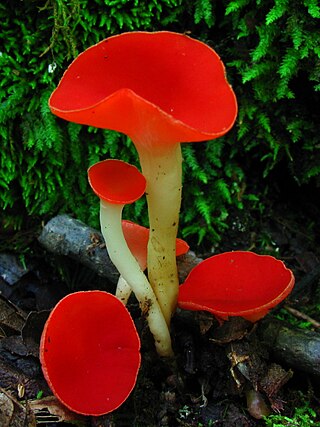
Sarcoscypha occidentalis, commonly known as the stalked scarlet cup or the western scarlet cup, is a species of fungus in the family Sarcoscyphaceae of the Pezizales order. Phylogenetic analysis has shown that it is most closely related to other Sarcoscypha species that contain large oil droplets in their spores. S. occidentalis has an imperfect form, classified as Molliardiomyces occidentalis.

Sarcoscypha dudleyi, commonly known as the crimson cup or the scarlet cup, is a species of fungus in the family Sarcoscyphaceae of the order Pezizales. It has been frequently confused with Sarcoscypha coccinea, but can be distinguished from this and other related species in Sarcoscypha by differences in microscopic characteristics, such as the presence and number of oil droplets in the spores. An imperfect form of the fungus, lacking a sexually reproductive stage in its life cycle, is classified as the species Molliardiomyces dudleyi.

Collybia tuberosa, commonly known as the lentil shanklet or the appleseed coincap, is an inedible species of fungus in the family Tricholomataceae, and the type species of the genus Collybia. Like the two other members of its genus, it lives on the decomposing remains of other fleshy mushrooms. The fungus produces small whitish fruit bodies with caps up to 1 cm (0.4 in) wide held by thin stems up to 5 cm (2.0 in) long. On the underside of the cap are closely spaced white gills that are broadly attached to the stem. At the base of the stem, embedded in the substrate is a small reddish-brown sclerotium that somewhat resembles an apple seed. The appearance of the sclerotium distinguishes it from the other two species of Collybia, which are otherwise very similar in overall appearance. C. tuberosa is found in Europe, North America, and Japan, growing in dense clusters on species of Lactarius and Russula, boletes, hydnums, and polypores.

Galiella rufa, commonly known as the rubber cup, the rufous rubber cup, or the hairy rubber cup, is a species of fungus in the family Sarcosomataceae. It produces cup-shaped fruit bodies with the texture of tough, gelatinous rubber, with a rough, blackish-brown, felt-like outer surface and a smooth reddish-brown inner surface.

Xylobolus frustulatus, commonly known as the ceramic fungus or ceramic parchment, is an inedible species of crust fungus in the Stereaceae family. The fruit body forms small, hard, flat crust-like aggregations that resemble broken pieces of ceramic tile. These pieces are initially whitish before turning yellow-brown to gray-brown in age. The spore-bearing cells cover the upper surfaces of the fruit body. A saprobic species, it grows on well-decayed oak wood in Asia, northern Europe, and North America.


















